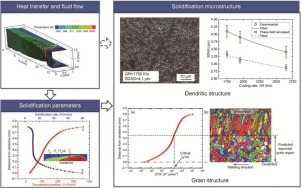Journal of Materials Science & Technology ( IF 10.9 ) Pub Date : 2020-01-08 , DOI: 10.1016/j.jmst.2019.10.027 Shaoning Geng , Ping Jiang , Xinyu Shao , Lingyu Guo , Xuesong Gao

|
Understanding the behaviors of heat transfer and fluid flow in weld pool and their effects on the solidification microstructure are significant for performance improvement of laser welds. This paper develops a three-dimensional numerical model to understand the multi-physical processes such as heat transfer, melt convection and solidification behavior in full-penetration laser welding of thin 5083 aluminum sheet. Solidification parameters including temperature gradient G and solidification rate R, and their combined forms are evaluated to interpret solidification microstructure. The predicted weld dimensions and the microstructure morphology and scale agree well with experiments. Results indicate that heat conduction is the dominant mechanism of heat transfer in weld pool, and melt convection plays a critical role in microstructure scale. The mushy zone shape/size and solidification parameters can be modulated by changing process parameters. Dendritic structures form because of the low G/R value. The scale of dendritic structures can be reduced by increasing GR via decreasing heat input. The columnar to equiaxed transition is predicted quantitatively via the process related G3/R. These findings illustrate how heat transfer and fluid flow affect the solidification parameters and hence the microstructure, and show how to improve microstructure by optimizing the process.
中文翻译:

铝板全穿透激光焊接中的传热和流体流动及其对凝固组织的影响
了解熔池中的传热和流体流动行为及其对凝固组织的影响,对于提高激光焊接性能具有重要意义。本文建立了一个三维数值模型,以了解薄的5083铝板全穿透激光焊接中的传热,熔体对流和凝固行为等多物理过程。凝固参数包括温度梯度G和凝固速率R评估其组合形式以解释凝固组织。预测的焊缝尺寸,显微组织形态和尺寸与实验吻合良好。结果表明,热传导是焊缝池传热的主要机理,而熔体对流在微观结构中起着至关重要的作用。糊状区域的形状/大小和凝固参数可以通过改变工艺参数来调节。由于低的G / R值,形成树突结构。可以通过减少热量输入来增加GR,从而降低树状结构的规模。通过与过程相关的G 3 / R定量预测柱状到等轴的转变。这些发现说明了传热和流体流动如何影响凝固参数,进而影响微观结构,并表明如何通过优化工艺来改善微观结构。



























 京公网安备 11010802027423号
京公网安备 11010802027423号